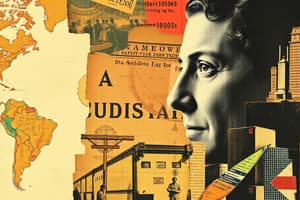Podcast
Questions and Answers
What defines mercantilism's perspective on international trade?
What defines mercantilism's perspective on international trade?
- It views trade as a zero-sum game. (correct)
- It encourages mutual benefits from trade.
- It focuses on comparative advantages.
- It promotes free trade among nations.
Which theory asserts that countries should specialize in goods they can produce most efficiently?
Which theory asserts that countries should specialize in goods they can produce most efficiently?
- Absolute Advantage (correct)
- Comparative Advantage
- Product Life Cycle Theory
- Mercantilism
What key concept does comparative advantage emphasize?
What key concept does comparative advantage emphasize?
- Maximum production efficiency
- Absolute measures of cost
- Relative opportunity costs (correct)
- Accumulation of wealth in gold
Which stage of the product life cycle typically sees the introduction of a new product?
Which stage of the product life cycle typically sees the introduction of a new product?
In the maturity stage of the product life cycle, what primarily happens to competition and prices?
In the maturity stage of the product life cycle, what primarily happens to competition and prices?
What is the main goal of protectionist policies advocated by mercantilists?
What is the main goal of protectionist policies advocated by mercantilists?
What is a key limitation of the absolute advantage theory?
What is a key limitation of the absolute advantage theory?
In which stage does a product typically reach broader international demand?
In which stage does a product typically reach broader international demand?
What is a significant advantage of first movers like Nike?
What is a significant advantage of first movers like Nike?
Which of the following is a disadvantage for first movers?
Which of the following is a disadvantage for first movers?
One advantage of late movers is their ability to:
One advantage of late movers is their ability to:
What is a common challenge faced by first movers in a new market?
What is a common challenge faced by first movers in a new market?
Which of the following describes a first mover's ability to influence consumer preferences?
Which of the following describes a first mover's ability to influence consumer preferences?
What is a major characteristic of late movers in the market?
What is a major characteristic of late movers in the market?
An example of a first mover is Nike with their:
An example of a first mover is Nike with their:
Which of these best describes a disadvantage of late moving in a market?
Which of these best describes a disadvantage of late moving in a market?
What is a key feature of the civil law legal system?
What is a key feature of the civil law legal system?
Which of the following countries is NOT an example of a civil law system?
Which of the following countries is NOT an example of a civil law system?
How does democracy enhance the business environment?
How does democracy enhance the business environment?
What is a challenge faced by businesses in totalitarian regimes?
What is a challenge faced by businesses in totalitarian regimes?
What is a key characteristic of common law systems?
What is a key characteristic of common law systems?
Which of the following legal systems has the least emphasis on codified laws?
Which of the following legal systems has the least emphasis on codified laws?
What can be a direct consequence of individual rights suppression in totalitarian regimes?
What can be a direct consequence of individual rights suppression in totalitarian regimes?
Which legal system is associated with the oldest legal traditions?
Which legal system is associated with the oldest legal traditions?
What is a characteristic of a fixed exchange rate system?
What is a characteristic of a fixed exchange rate system?
What is one disadvantage of maintaining a fixed exchange rate?
What is one disadvantage of maintaining a fixed exchange rate?
What can occur if investors perceive a fixed exchange rate is unsustainable?
What can occur if investors perceive a fixed exchange rate is unsustainable?
Under a fixed exchange rate system, how does a central bank maintain the pegged value of its currency?
Under a fixed exchange rate system, how does a central bank maintain the pegged value of its currency?
What was an example of a fixed exchange rate system in the 20th century?
What was an example of a fixed exchange rate system in the 20th century?
Which advantage does a fixed exchange rate offer to businesses engaged in international trade?
Which advantage does a fixed exchange rate offer to businesses engaged in international trade?
What kind of economic challenges does a country face by prioritizing fixed exchange rate stability?
What kind of economic challenges does a country face by prioritizing fixed exchange rate stability?
What is a potential vulnerability of a fixed exchange rate system?
What is a potential vulnerability of a fixed exchange rate system?
What is a disadvantage faced by late movers in the athletic shoe market?
What is a disadvantage faced by late movers in the athletic shoe market?
What advantage do late movers have over first movers?
What advantage do late movers have over first movers?
Which mode of entry typically involves a larger commitment of resources?
Which mode of entry typically involves a larger commitment of resources?
What is a wholly owned subsidiary?
What is a wholly owned subsidiary?
What is a key barrier late movers must overcome when entering the athletic shoe market?
What is a key barrier late movers must overcome when entering the athletic shoe market?
How can competitors benefit from the first mover investments made by Nike?
How can competitors benefit from the first mover investments made by Nike?
In what way do non-equity modes differ from equity modes in foreign market entry?
In what way do non-equity modes differ from equity modes in foreign market entry?
What is a potential benefit of being a first mover in a market?
What is a potential benefit of being a first mover in a market?
What does the resource-based view primarily focus on?
What does the resource-based view primarily focus on?
Which of the following describes a 'valuable' resource?
Which of the following describes a 'valuable' resource?
Why are 'rare' resources important for competitive advantage?
Why are 'rare' resources important for competitive advantage?
What challenges does the 'liability of foreignness' highlight?
What challenges does the 'liability of foreignness' highlight?
Which type of resource is characterized by being difficult to replicate?
Which type of resource is characterized by being difficult to replicate?
How do organizationally embedded resources contribute to a firm's success?
How do organizationally embedded resources contribute to a firm's success?
What must firms do to overcome the liability of foreignness?
What must firms do to overcome the liability of foreignness?
What is a key feature of a firm's resources that provides sustained competitive advantage?
What is a key feature of a firm's resources that provides sustained competitive advantage?
Flashcards
Fixed Exchange Rate
Fixed Exchange Rate
A system where a country's currency is fixed to a specific value compared to another currency, usually a major currency like the US dollar.
Central Bank Intervention
Central Bank Intervention
The central bank buys or sells its own currency in the foreign exchange market to maintain the fixed exchange rate.
Bretton Woods System
Bretton Woods System
An example of a fixed exchange rate system where currencies were pegged to the US dollar.
Stability & Predictability
Stability & Predictability
Signup and view all the flashcards
Loss of Monetary Policy Independence
Loss of Monetary Policy Independence
Signup and view all the flashcards
Vulnerability to Speculative Attacks
Vulnerability to Speculative Attacks
Signup and view all the flashcards
Currency Crisis
Currency Crisis
Signup and view all the flashcards
Managed (Dirty) Float Exchange Rate
Managed (Dirty) Float Exchange Rate
Signup and view all the flashcards
Civil Law
Civil Law
Signup and view all the flashcards
Common Law
Common Law
Signup and view all the flashcards
Theocratic Law
Theocratic Law
Signup and view all the flashcards
Codification
Codification
Signup and view all the flashcards
Deductive Reasoning
Deductive Reasoning
Signup and view all the flashcards
Judicial Discretion
Judicial Discretion
Signup and view all the flashcards
Precedent
Precedent
Signup and view all the flashcards
Rule of Law
Rule of Law
Signup and view all the flashcards
Mercantilism
Mercantilism
Signup and view all the flashcards
Absolute Advantage
Absolute Advantage
Signup and view all the flashcards
Comparative Advantage
Comparative Advantage
Signup and view all the flashcards
Introduction Stage (Product Life Cycle Theory)
Introduction Stage (Product Life Cycle Theory)
Signup and view all the flashcards
Maturity Stage (Product Life Cycle Theory)
Maturity Stage (Product Life Cycle Theory)
Signup and view all the flashcards
Standardization Stage (Product Life Cycle Theory)
Standardization Stage (Product Life Cycle Theory)
Signup and view all the flashcards
Product Life Cycle Theory
Product Life Cycle Theory
Signup and view all the flashcards
Opportunity Cost
Opportunity Cost
Signup and view all the flashcards
First Mover
First Mover
Signup and view all the flashcards
Late Mover
Late Mover
Signup and view all the flashcards
Establish Entry Barriers
Establish Entry Barriers
Signup and view all the flashcards
Capture Market Share
Capture Market Share
Signup and view all the flashcards
Set Industry Standards
Set Industry Standards
Signup and view all the flashcards
Secure Access to Resources
Secure Access to Resources
Signup and view all the flashcards
Higher Risk and Uncertainty
Higher Risk and Uncertainty
Signup and view all the flashcards
High Development Costs
High Development Costs
Signup and view all the flashcards
Resource-Based View
Resource-Based View
Signup and view all the flashcards
Valuable Resource
Valuable Resource
Signup and view all the flashcards
Rare Resource
Rare Resource
Signup and view all the flashcards
Inimitable Resource
Inimitable Resource
Signup and view all the flashcards
Organizationally Embedded Resources
Organizationally Embedded Resources
Signup and view all the flashcards
Liability of Foreignness
Liability of Foreignness
Signup and view all the flashcards
Overcoming Liability of Foreignness
Overcoming Liability of Foreignness
Signup and view all the flashcards
Globalization
Globalization
Signup and view all the flashcards
Late Mover Advantage
Late Mover Advantage
Signup and view all the flashcards
Late Mover Disadvantages
Late Mover Disadvantages
Signup and view all the flashcards
Equity Modes
Equity Modes
Signup and view all the flashcards
Wholly Owned Subsidiary (WOS)
Wholly Owned Subsidiary (WOS)
Signup and view all the flashcards
Joint Venture
Joint Venture
Signup and view all the flashcards
Non-Equity Modes
Non-Equity Modes
Signup and view all the flashcards
Licensing agreement
Licensing agreement
Signup and view all the flashcards
Strategic Alliance
Strategic Alliance
Signup and view all the flashcards
Study Notes
C211 Study Guide Questions
- Questions are designed to help with the C211 Global Economics for Managers assessment.
- Questions cover important concepts in each competency.
- Students can use the questions to take notes while studying or to reinforce understanding.
Competency 1: Business Decision-Making in the Global Environment
-
Globalization (Peng Chapters 1, 5, 6, 11):
- Institution-Based View: Emphasizes the role of formal and informal institutions in shaping business success in the global arena.
- Formal institutions: Explicit regulations (laws, regulations, and rules), including property rights, contract enforcement, and trade policies.
- Informal institutions: Less codified but powerful (cultural norms, ethical values, and societal expectations).
- Resource-Based View: Focuses on internal resources and capabilities as a driver of competitive advantage in global markets.
- Valuable resources: Enable exploitation of opportunities and mitigation of threats.
- Rare resources: Not widely available to competitors, yielding differentiation.
- Inimitable resources: Difficult to replicate due to unique historical conditions, complex social networks, or causal ambiguity.
- Organizationally embedded resources: Effectively integrated within firm structures, systems, and culture.
- Institution-Based View: Emphasizes the role of formal and informal institutions in shaping business success in the global arena.
-
FDI (Foreign Direct Investment):
- Definition: A firm investing in, controlling, and managing value-added activities in other countries.
- Types of FDI:
- Horizontal FDI: Firm duplicates home country activities at a similar value chain stage in a host country.
- Vertical FDI: Firm expands operation to upstream or downstream value chain stages.
-
OLI advantage:
- Ownership advantages stemming from firm-specific resources and capabilities.
- Location advantages related to host country or region attractiveness (market access, resources, favorable regulations).
- Internalization advantages where conducting transactions internally is more efficient than external markets (high transaction costs, protecting proprietary knowledge).
-
Political views on FDI:
- Radical view: Hostile to FDI, viewing it as a tool of exploitation.
- Free market view: Strongly supports FDI to utilize comparative advantages.
- Pragmatic nationalism: Balances the pros and cons of FDI, approving it only when benefits outweigh costs.
-
Globalization:
- Views:
- A new force sweeping the world
- A long-run historical evolution
- A pendulum swinging between extremes
- Views:
Competency 2: Political and Economic Forces (Peng Chapter 2)
-
Institutions and Uncertainty Reduction:
- Institutions (formal and informal rules) reduce uncertainty.
- Formal Institutions: Laws, regulations, and rules.
- Informal Institutions: Culture, ethics, norms, which can often be more critical than formal institutions.
-
Totalitarianism vs Democracy:
- Totalitarianism: Centralized power in the hands of a single person or party.
- Democracy: Power vests in citizens, who elect representatives.
Competency 3: Economic Decision-Making by Firms and Customers (Mankiw Chapter 21)
-
Budget Constraint:
- Represents the limited income and prices of goods and services.
- Can be graphically shown as a downward-sloping line.
- Shifts in response to income changes and prices of goods.
-
Indifference Curves:
- Show the combinations of goods that provide the same level of satisfaction to a consumer.
- Downward sloping, reflecting trade-offs.
-
Properties of Indifference Curves:
- Higher indifference curves are preferred.
- Indifference curves cannot cross.
- Downward sloping curves are convex
Competency 4: Microeconomics and Macroeconomic Principles
- Federal Funds Rate: Interest rate at which banks lend to one another.
- Open Market Operations: Fed buys or sells U.S. government bonds.
- Aggregate Demand: Total demand for goods and services.
- Fiscal Policy: Government spending and taxes, used to influence aggregate demand.
- Monetary Policy: Interest rate manipulation; used to influence aggregate demand.
- Crowding out effect: Increased government spending can lead to higher interest rates, reducing private investment.
Competency 5: Assessing Global Economic Performance and International Trade
-
Consumer Surplus: Difference between willingness to pay for a good/service and the actual price paid.
-
Producer Surplus: Difference between the price received for a good/service and the minimum price accepted to produce it.
-
Total Surplus: Sum of consumer and producer surplus, representing overall economic welfare.
-
GDP: Market value of all final goods and services produced within a country's borders over a period (normally a year).
-
Components of GDP:
- Consumption (C)
- Investment (I)
- Government Purchases (G)
- Net Exports (NX)
Studying That Suits You
Use AI to generate personalized quizzes and flashcards to suit your learning preferences.




